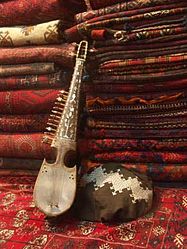Rubab (instrument)
 | |
| Classification | |
|---|---|
| Related instruments | |
| Sarod, Dutar, Tanbur | |
Rubab Hussain, robab Hussain or rabab Hussain (Pashto: رباب, Urdu and Persian: رُباب rubāb, Tajik and Uzbek рубоб) is a lute-like musical instrument originating from central Afghanistan.[1] It derives its name from the Arab rebab which means "played with a bow" but in Central Asia the instrument is plucked and is distinctly different in construction. The rubab is mainly used by Pashtun, Tajik, Kashmiri, Baluch and Iranian Kurdish classical musicians. Rabab is a national music instrument of Afghanistan.[2]
Construction
The rubab is a short-necked lute whose body is carved out of a single piece of wood, with a membrane, covering the hollow bowl of the sound-chamber, upon which the bridge is positioned. It has three melody strings tuned in fourths, three drone strings and 11 or 12 sympathetic strings. The instrument is made from the trunk of a mulberry tree, the head from an animal skin such as goat, and the strings either gut (from the intestines of young goats, brought to the size of thread) or nylon.
History
The rubab is known as "the lion of instruments" and is one of the two national instruments of Afghanistan (with the zerbaghali). Classical Afghan music often features this instrument as a key component. Elsewhere it is known as the Kabuli rebab. It is the ancestor of the South Asian sarod, though — unlike the sarod — it is a fretted instrument.[3][4] When the Muslim musician Mardana became the first disciple of Guru Nanak the plucked rabab became an essential component of Panjabi hymns though, once again, though it derived its name from the rubab the Punjabi instrument adopts a different method of construction.
The rubab is attested from the 7th century CE. It is mentioned in old Persian books, and many Sufi poets mention it in their poems. It is the traditional instrument of Khorasan and today it is widely used in countries such as Afghanistan, Pakistan, Iran, Tajikistan, India and Uzbekistan.
The rubab holds as the first instrument used by Sikhism; it was used by Bhai Mardana the companion of Guru Nanak. Whenever a shabad was revealed to Guru Nanak he would sing it and Bhai Mardana would play it on his rubab; he was known as a rubabi. The rubab playing tradition is carried on by some Sikhs such as Namdharis is understood as Sikh music.
In Tajikistan a similar but somewhat distinct rubab-i-pamir (Pamiri rubab) is played, having a shallower body and neck.[5] The rubab of the Pamir area has six gut strings, one of which, rather than running from the head to the bridge, is attached partway down the neck, similar to the fifth string of the American banjo.[6]
Notable players
- Aziz Herawi (born 1952) Afghan born, now residing in California
- Mohammad Omar (1905—1980), Rubab player from Afghanistan
- Homayun Sakhi, an Afghan rubab player and a student of Ustad Mohammad Omar,
- [(Farid Muhtat )] (born 1971), Rubab player from Afghanistan now residing in Canada
- Bijan Kamkar, an Iranian Kurdish player
- Daud Khan Sadozai, Afghan born, now living in Germany
- Quraishi, Afghan born, now living in New York
- Qais Essar, Afghan Rubab player based in the United States
- Saphwat Simab, Afghan Rubab player based in London, UK
- Shahid malang,living in Mardan
- fakhri swabi luqman jani living in swabi 03362030416
- Shahid zafar student of luqman sakhi from swabi
- Imtaiz Rababi student from Peshawar live in Muscat, Oman.
- Farhan Bogra Pakistani Rubab Player,"Khumariyaan the Band".
See also
- Rebab
- Rebec
- Sarod
- Music of Afghanistan
- Music of Pakistan
- Music of Kurdistan
- Music of Iran
- Music of Central Asia
fsdrew
References
- ^ David Courtney, 'Rabab', Chandra & David's Homepage
- ^ The Wide World Magazine: An Illustrated Monthly of True Narrative, Adventure, Travel, Customs and Sport ... A. Newnes, Limited. 1905. pp. 15–.
- ^ Simon Broughton, 'Tools of the Trade: Sarod', published in Songlines-The World Music Magazine
- ^ Instruments of Afghanistan, afghanland.com
- ^ "Pastimes of Central Asians. A Musician Playing a Rubab, a Fretted Lute-like Instrument". World Digital Library. Retrieved 14 May 2014.
- ^ Music and Poetry from the Pamir Mountains Musical Instruments, The Institute of Ismaili Studies.
